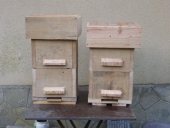Secondly - DONT PANIC
* A Shady Spot sounds indeed like a good idea. It is here (climate 6-7).
* Feeding - Learn to monitor your landscape. Is there a honey flow? Is there enough pollen? As a beekeeper, you will soon learn to watch your surroundings with very different eyes than before.
+ If you have a langstroth hive, it is easy to lift the hive with one hand to check, if there is enough storage left. You will soon get a feel for this. In an emergency it is always better to feed the bees, than let them starve. If you have some honey harvest left, feed them their own honey back, if not - feed them a sugarsolution. Never buy honey in the supermarket to feed the bees. This honey might be contaminated with paenibacillus larvae (american foulbrood), there is no cure against this. If a hive is too light, before you blame the bees, check if it is your fault - was your harvest a little more, than they could spare? Selecting and breeding for a local bee is a good idea, but you need more than one hive to have something to select from.
* Langstroth hive and frames - Of course you can run a langstroth hive foundationless, you can even run it as a top bar hive. But there is one big difference to a horizontal TBH. In a langstroth hive, the bees need to move vertically through the hive. This means, you need to reduce the width of your top bars to 28mm and make sure there is an open gap of 7mm (beespace) betweeen the bars. (two small nails at one side of the top bar will do the trick) It is important to get those measurements very precisely, otherwise you are better of to work your langstroth similar to a perone hive mk1. (Checking with the way perone keeps bees, is probably not a bad idea at all)
* buckwheat - if you like buckwheat honey - ok. (I do, but I know a lot of people who don't) But remember, that buckwheat is in flower for two to three months only. What about the rest of the season? Diversification is the key.
* protective gear - a good investment - especially if you are new to beekeeping. Did I say - don't panic? Bees know if you are scared, your movements are not slow and steady, you smell differently. Some protection especially for your face, might give you that additional feeling of safety, that allows you to handle the bees in a beefriendly manner. Try to work without gloves if you can, gloves hinder your sense of touch, but don't be ashamed to wear a light veil to protect your face.
happy beekeeping - and continue asking!
Ludger



